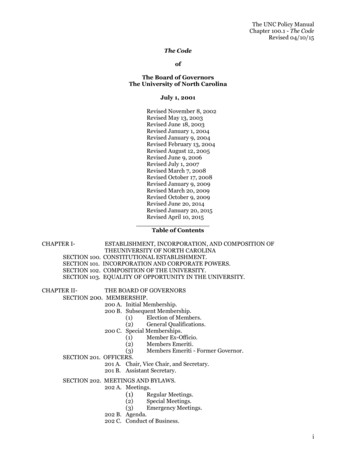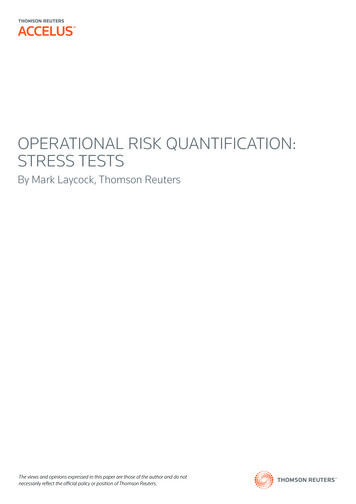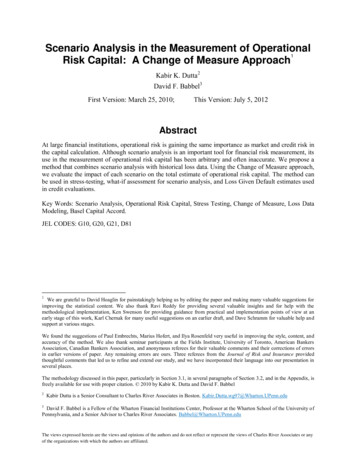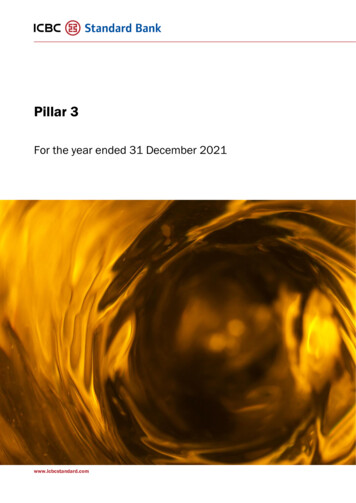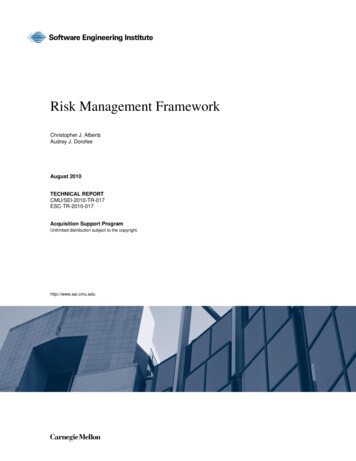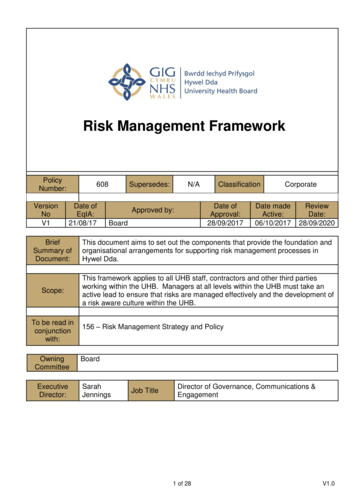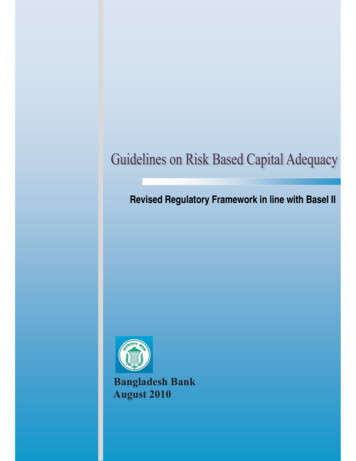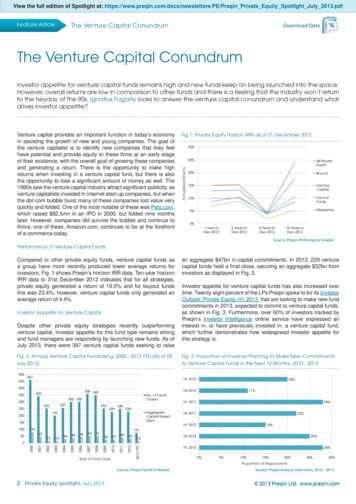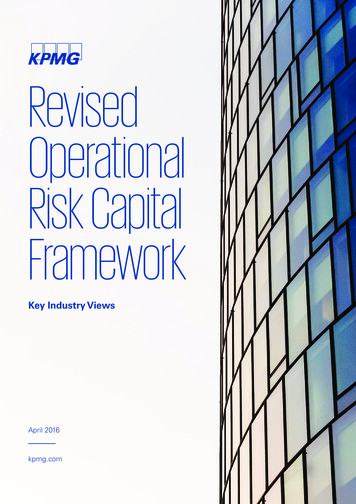
Transcription
RevisedOperationalRisk CapitalFrameworkKey Industry ViewsApril 2016kpmg.com 2016 KPMG International Cooperative (“KPMG International”), a Swiss entity. Member firms of the KPMG network of independent firms are affiliatedwith KPMG International. KPMG International provides no client services. No member firm has any authority to obligate or bind KPMG International or anyother member firm vis-à-vis third parties, nor does KPMG International have any such authority to obligate or bind any member firm. All rights reserved.
SummaryOn 4 March 2016 the Basel Committee onBanking Standards (BCBS) released the longawaited revised consultation paper on operationalrisk capital . This proposed to scrap internalmodelling (under the Advanced MeasurementApproach, AMA) and revise all currentapproaches to, instead, measuring operationalrisk capital with one Standardised MeasurementApproach (SMA). The BCBS has subsequentlyalso published a consultation paper on revisedPillar 3 disclosure requirements , includingamendments relating to operational risk. Theseinclude revising disclosures to meet the newlyproposed SMA, additional disclosures of internallosses, and detailed information relating to theoperational risk management framework.Two weeks following the release of theconsultation, KPMG in the UK held a roundtablediscussion with senior operational riskrepresentatives from across the industry todebate these new proposals. The roundtable wasconducted under the Chatham House Rule. Therewere thirteen participants across a mix of G-SIBs,larger banks, and smaller UK-focussed firms,with firms currently adopting The StandardisedApproach (TSA) and the AMA. The discussionswere wide ranging with lots of insights and viewsshared on the proposals themselves and morebroadly regarding the future of operational riskmanagement.2Revised Operational Risk Capital Framework 2016 KPMG International Cooperative (“KPMG International”), a Swiss entity. Member firms of the KPMG network of independent firms are affiliatedwith KPMG International. KPMG International provides no client services. No member firm has any authority to obligate or bind KPMG International or anyother member firm vis-à-vis third parties, nor does KPMG International have any such authority to obligate or bind any member firm. All rights reserved.
Top 5 Key Themes1. The new proposals do not capture the full picturein relation to operational riskThere was a consistent view across participants that the new proposals only covera portion of operational risk management and measurement, and in themselves areunhelpful in improving operational risk across the industry. While the consultationpaper is focused on the measurement of pillar 1 operational risk capital, it wassuggested that further guidance on good operational risk management practices andthe linkage with stress-testing would be helpful to provide the wider context of theBCBS proposals and its links to other components of the operational risk framework.It may also show how, overall, the framework is risk-sensitive – 92% of participantsthought the proposal was not risk-sensitive enough on a standalone basis.92%of participants thoughtthe proposal was notrisk-sensitive enough ona standalone basis.In addition, the consultation paper only mentions that the AMA, in the form it wasintroduced in 2006, did not meet the BCBS’s expectations and therefore removalis warranted. However, it was felt that the paper could have gone into more detailbreaking the AMA down and explaining which parts did and did not work, andtherefore potentially discussing how the modelling approach could be refinedrather than throwing the baby out with the bath water and simply removing italtogether. In general, it was felt a better approach would be to keep some form ofinternal modelling that is a revised version of the AMA, but that is a simpler, moreprescriptive modelling approach that is consistent across jurisdictions.The proposals for Pillar 1 are much simpler (than AMA) and more detaileddisclosure would be required under Pillar 3. Combined, it was felt that thesechanges do improve comparability across organisations. But Pillar 2 figures andmethodologies will continue to remain opaque and particularly incomparableacross jurisdictions as local supervisors continue to have very different approachesto Pillar 2 operational risk capital. 2016 KPMG International Cooperative (“KPMG International”), a Swiss entity. Member firms of the KPMG network of independent firms are affiliatedwith KPMG International. KPMG International provides no client services. No member firm has any authority to obligate or bind KPMG International or anyother member firm vis-à-vis third parties, nor does KPMG International have any such authority to obligate or bind any member firm. All rights reserved.Revised Operational Risk Capital Framework3
2. Capital levels are likely to increaseThe BCBS has stated that while the objective of these proposals is not tosignificantly increase overall capital requirements, the impact of the newframework will vary from bank to bank and may lead to an increase in minimumcapital requirements for some banks. Of participating banks, 83% confirmed thatthey anticipated their Pillar 1 capital requirements would increase due to the SMA,with a quarter of firms thinking the impact would be greater than a 70% rise. Someparticipants may be slightly better off under Pillar 1 due to more conservative andprescriptive current approach to capital requirements by home supervisors, but theview was that this wouldn’t be the case when looking at overall capital levels.83% of participants anticipatedtheir Pil ar 1 capitalrequirements wouldincrease due to the SMA,with a quarter of firmsthinking the impact wouldbe greater than a 70% rise.It was observed that over recent years internal losses have increased more rapidlythan banks’ capital levels. Since the SMA approach incorporates internal losses(for banks in buckets 2-5) as an element to enhancing risk-sensitivity, capitalrequirements are likely to increase further given the growing internal losses.Another impact outlined was that since 10 years’ worth of loss data would berequired for the SMA (for banks in buckets 2-5), any significant internal loss eventtaking place would increase capital levels for the following 10 years, despiteany efforts by the firm to enhance the control environment, including spendingsignificant sums on remediation.For smaller banks (in bucket 1) under SMA their capital would not depend on theirinternal losses. As a result, participants believed the proposed approach couldpossibly reduce their current Pillar 1 capital levels since the coefficient for theproposed Business Indicator under SMA would be 11% which is lower than thecurrent coefficients for the Basic Indicator Approach (BIA) and TSA approaches of15% and 12%-18% respectively.4Revised Operational Risk Capital Framework 2016 KPMG International Cooperative (“KPMG International”), a Swiss entity. Member firms of the KPMG network of independent firms are affiliatedwith KPMG International. KPMG International provides no client services. No member firm has any authority to obligate or bind KPMG International or anyother member firm vis-à-vis third parties, nor does KPMG International have any such authority to obligate or bind any member firm. All rights reserved.
3. Incentivising good operational risk management will be more challengingParticipants believed AMA was and remains a good wayto incentivise firms to maintain robust operational riskmanagement since it takes into account internal losses,scenario analysis, and the business environment andinternal control factors within a firm – i.e. there is a directlink between improving operational risk management andreducing operational risk capital.77%of participants wereconcerned that theSMA would not incentivisecontinual improvements inoperational risk management.Whilst the SMA proposal tries to address the risksensitivity aspect, it was felt that under SMA there wouldbe significantly fewer incentives to strengthen operationalrisk management given that internal loss data would be theonly component of the framework that would remain as partof the Pillar 1 capital calculations. As an example, since thecalculation uses 10 years of a firm’s internal loss data thena one-off significant loss would impact capital levels for thefollowing 10 years, and so there would be reduced incentivesfor improving risk management within the organisation duringthis period. Seventy seven percent of participants wereconcerned that the SMA would not incentivise continualimprovements in operational risk management.Banks’ view was that going forward Pillar 2 capitalrequirements would be the engine for promoting robustoperational risk management and maintaining the forwardlooking element to operational risk measurement. However,the consistency and comparability across the industryin relation to Pillar 2 capital requirements was an area ofconcern for participants given the variation of approachesadopted by supervisors globally. Ninety percent ofparticipants could not foresee a globally consistent approachbeing applied by supervisors in relation to Pillar 2 operationalrisk capital – conversely 60% thought a consistent approachwould be applied for Pillar 1 given the new requirement.Participants believed that the other operational risk frameworktools omitted from this proposal such as external loss dataand scenario analysis have proved to be very informativeand useful elements for operational risk management withinfirms. They have engaged the business as they help to showwhat could potentially happen and what they, as the business,should be aware of and looking out for. They also feed into thebanks internal stress-testing processes.Firms should seek to ensure they have robust systemsand processes in place, embedded within the business,for capturing internal loss data, since this will be a criticalcomponent of the Pillar 1 capital calculation under the SMA.It is therefore important for firms to have a risk culture withinthem of proactive raising and reporting of incidents andevents in a timely manner.Participants were concerned about how to encourage thiswithout strong capital incentives and with recourse beingsevere, particularly with the implementation of the SeniorManager and Certification Regimes (SMCR) in the UK makingindividuals more accountable. The view was that generallythis proactive reporting is encouraged due to the threat ofpotential consequences being more severe if the issue isdiscovered at a later stage and nothing had previously beenescalated. However, participants also felt that SMCR may, initself, also incentivise good risk management due to SeniorManagers having to demonstrate that they have taken‘reasonable steps’.90% 2016 KPMG International Cooperative (“KPMG International”), a Swiss entity. Member firms of the KPMG network of independent firms are affiliatedwith KPMG International. KPMG International provides no client services. No member firm has any authority to obligate or bind KPMG International or anyother member firm vis-à-vis third parties, nor does KPMG International have any such authority to obligate or bind any member firm. All rights reserved.of participants could notforesee a globally consistentapproach being appliedby supervisors in relationto Pillar 2 operational riskcapital – conversely 60%thought a consistentapproach would be appliedfor Pillar 1 given the newrequirement.Revised Operational Risk Capital Framework5
4. Further guidance is required in the detail of the proposalsParticipants felt that the proposals lacked a necessary levelof granularity in some areas, both in terms of the Pillar 1calculation (what is or isn’t included in the internal loss data,what is or isn’t included in the Business Indicator calculation)and the Pillar 3 disclosures (what should or shouldn’t becaptured and disclosed).75%Some examples of areas requiring further guidance included: The recognition, treatment and timing of provisions foroperational risk contingencies How should boundary events be treated? Will they bedouble counted? How should litigation events and fines be incorporated? How do different detailed elements of the financialstatements fit into the different Business Indicatorcomponents? How should derivatives be treated and what are theimplication of and on hedge accounting?of participants thought their systems andprocesses would largely capture the datathat would meet the new requirements,and their infrastructure would not requiresignificant change. Will businesses that are being divested need to beincorporated into the calculations and disclosures?If more detailed guidance is not provided then participantsfelt there is a risk that firms will have different interpretationsand use different approaches for what is and isn’t included,thereby reducing the comparability and transparency soughtby the BCBS. Is the internal loss threshold strictly 10,000 or will it be10,000 in local currency? This would have a significantimplication when looking back at 10 years’ worth of historiclosses due to fluctuations in foreign exchange rates,without significantly improving transparency or stability.However, despite these open questions regarding the datarequirements, 75% of participants thought their systems andprocesses would largely capture the data that would meetthe new requirements, and their infrastructure would notrequire significant change. Which trading losses should be captured as operationalrisk losses?6Revised Operational Risk Capital Framework 2016 KPMG International Cooperative (“KPMG International”), a Swiss entity. Member firms of the KPMG network of independent firms are affiliatedwith KPMG International. KPMG International provides no client services. No member firm has any authority to obligate or bind KPMG International or anyother member firm vis-à-vis third parties, nor does KPMG International have any such authority to obligate or bind any member firm. All rights reserved.
5. The Pillar 3 disclosure requirements are welcomed38%thinking the industryshould have accessto this level of data.Participants thought the operational risk changes includedwithin the Pillar 3 proposals were positive with a view thatthese would help educate individuals within firms as well asthe broader industry on operational risk, and should be helpfulto external investors and the market, with 38% thinking theindustry should have access to this level of data.77%of participantsthought the Pil ar3 changes wilhelp improvetransparency andcomparabilityacross banksAlso, 77% of participants thought the Pillar 3 changes willhelp improve transparency and comparability across banks, atleast from a Pillar 1 perspective.Is there a better approach?The BCBS consultation has asked firms to comment onthe current proposals. They also said they may consideralternative approaches to ensure a stable and risk-sensitiveframework, so firms are encouraged to offer alternativeapproaches if they think these would be better.This was seen somewhat as a surprise to firms since theBCBS has been consulting and drafting proposals for over2 years (the previous consultation paper was released inOctober 2014 prior to this revised paper) and it has beeninformed by local regulators and firms contributing toQuantitative Impact Studies (QIS).Some alternative suggestions discussed during ourroundtable event were to: Maintain an internal modelling approach, but be moreprescriptive about how to apply this approach, for examplestandardising data collection and providing stricterguidance on the use of the 4 data elements. Ensure international approaches to supervision andregulatory expectations of operational risk measurementand management (under all 3 pillars of the capitalframework) were aligned through BCBS guidance orintroduced global benchmarking. Look at operational risk measurement and managementholistically rather than piecemeal (i.e. not separatingout pillar 1, 2 and 3 as well as other guidance suchas the BCBS Principles for the Sound Managementof Operational Risk), ensuring there remains strongincentives for good operational risk management,sufficient capital for helping to mitigate large, unexpectedtail events, as well as striking the balance between risksensitivity, complexity, and comparability. 2016 KPMG International Cooperative (“KPMG International”), a Swiss entity. Member firms of the KPMG network of independent firms are affiliatedwith KPMG International. KPMG International provides no client services. No member firm has any authority to obligate or bind KPMG International or anyother member firm vis-à-vis third parties, nor does KPMG International have any such authority to obligate or bind any member firm. All rights reserved.Revised Operational Risk Capital Framework7
Contact usKarim HajiPartner, Financial ServicesKPMG in the UKE: karim.haji@kpmg.co.ukHeather TownsonSenior Manager, Operational RiskKPMG in the UKE: heather.townson@kpmg.co.ukLisa AfonsoManager, Operational RiskKPMG in the UKE: lisa.afonso@kpmg.co.ukkpmg.com/socialmediaThe information contained herein is of a general nature and is not intended to address the circumstances of any particular individual or entity. Although we endeavour to provide accurate and timelyinformation, there can be no guarantee that such information is accurate as of the date it is received or that it will continue to be accurate in the future. No one should act on such information withoutappropriate professional advice after a thorough examination of the particular situation. 2016 KPMG International Cooperative (“KPMG International”), a Swiss entity. Member firms of the KPMG network of independent firms are affiliated with KPMG International. KPMG Internationalprovides no client services. No member firm has any authority to obligate or bind KPMG International or any other member firm vis-à-vis third parties, nor does KPMG International have any suchauthority to obligate or bind any member firm. All rights reserved.The KPMG name and logo are registered trademarks or trademarks of KPMG International.Create Graphics CRT059424 April 2016
to incentivise firms to maintain robust operational risk management since it takes into account internal losses, scenario analysis, and the business environment and internal control factors within a firm - i.e. there is a direct link between improving operational risk management and reducing operational risk capital.
